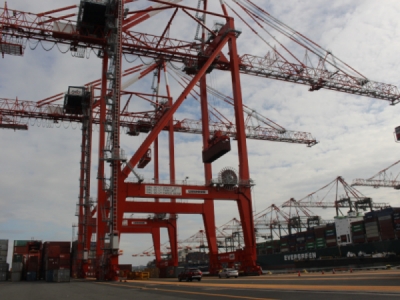
Posted on May 15, 2019
The Port of New York and New Jersey says marine terminals are not only seeing more 13,000-TEU ships, but more importantly, they are handling the stronger discharges — between 2,000 to 3,000 more TEU per call — more efficiently than they were a year ago.
Although ships with a capacity of 13,000 TEU or more now carry more than 20 percent of all containers handled by the port, the marine terminals have handled the resulting increase in cargo discharge volumes relatively smoothly, with some adjustments in terminal operating procedures, the Port Authority of New York and New Jersey told JOC.com. That should come as a relief to shippers watching to see whether the port, which is subject to sporadic congestion, would be able to handle the larger vessels and their bigger payloads.
Since June 2018, the 50 largest cargo exchanges in the port have all involved a vessel of 13,000 TEU or larger, and the average cargo exchange on those ships is about 13,000 TEU, said Beth Rooney, deputy director of the port authority’s port division. Port Newark Container Terminal (PNCT) said the average container volume exchanged per call at the terminal in 2019 is 14.2 percent higher than a year ago.
An elevated Bayonne Bridge
The escalation in New York-New Jersey mega-ship volumes has largely unfolded since the opening of the elevated Bayonne Bridge two years ago, which enabled vessels of larger than 9,500 TEU to call at four of the port’s five main terminals, instead of just one. Port officials say that fears of congestion and lack of equipment as vessel size increased voiced before the bridge was raised have not been borne out.
Port fluidity still gets challenged, however. APM Terminals suffered severe truck congestion and extended dwell times of containers on its rail dock at the start of the year after Zim Integrated Shipping Services partnered with the 2M Alliance and began sending cargo through APM instead of Maher Terminals.
In 2017, only 0.9 percent of the containers that came in and out of the port was carried on a vessel of 13,000 TEU or greater, Rooney said. Last year, 15.9 percent of the containers were transported on ships of that size, and so far this year, that number has risen to 22.7 percent, Rooney said.
The impact on cargo discharge volumes can be seen in the experience of a 13,208-TEU vessel that called the port in September 2018 and exchanged 13,189 TEU, she said.
“The same vessel called last month and discharged 14,279 TEUs,” she said, an increase of 8.3 percent. “The size of the exchange on the bigger ships is increasing,” she said, adding that the port expected the big ships and the volume of cargo needed to fill them to “phase in” over time.
“Terminals are all handling the increased vessel exchanges without any issues,” Rooney said. “Large vessel exchanges might use more ship to shore cranes which increases the manpower and yard equipment that are deployed to support the extra crane[s]. Additional hours of cargo operations may also be needed.”
Marine terminals adapting to bigger ships
The exchange volume figures present a significant change from a year ago, when port officials reported that although the size of vessels coming into the port had increased, the cargo discharge from vessels larger than 10,000 TEU was about the same as for 8,500 TEU vessels, which exchanged a larger volume of their vessel capacity.
Chris Garbarino, chief operating officer for PNCT, said that the experience of handling more than 100 vessels of 10,000 TEU or greater has shown that “it has become increasingly important to increase collaboration and information sharing with carriers to effectively plan operations for large ships.”
“We have been pushing to get discharge size immediately after ships sail last port of call and are also pushing to get empty evacuation projections as soon as possible,” Garbarino said. “All of this helps plan the future ship operation and terminal yard/gate operations to support it.”
Three services from Asia now stop at the port regularly with vessels of 10,000 TEU or more, two from the Ocean Alliance, and one from THE Alliance, Rooney said. On May 30, Triton, a 14,000-TEU vessel that’s 168 feet wide and 1,200 feet long, will become the longest and widest vessel ever to pass under the Bayonne Bridge and down the Kill Van Kull, the channel that leads to the terminals, according to the New York Sandy Hook Pilots Association. The Evergreen vessel will call at Maher Terminals, on a route from China through the Panama Canal.
Triton’s arrival follows the April 27 call at GCT Bayonne of YM World, a 13,900-TEU vessel that is the first mega-vessel operated by Yang Ming to stop at New York-New Jersey. The largest vessel by cargo volume that comes into the port carries 14,439 TEU, the port authority said.
The port handled 6.5 percent more cargo, 5.01 million loaded TEU, in 2018 compared with 2017, according to PIERS, a JOC.com sister company within IHS Markit. That outpaced the cargo growth through ports on the East Coast, which increased by 5 percent, and the United States as a whole, which grew by 5.15 percent, the figures show. Imports into New York-New Jersey from Asia increased by 8.2 percent in 2018, compared with 7.6 percent on the East Coast and 7.2 percent for the US as a whole.
Loaded cargo through New York-New Jersey is up 2.2 percent in the first quarter of 2019, according to port authority figures.
Captain John J. DeCruz, president of the New York Sandy Hook Pilots Association, said the pilots have heard that a carrier may soon introduce a 15,000-TEU vessel, but that the increasing ship size is now fairly routine. “We are getting used to these ships now, so it’s nothing really special,” he said.
Source: joc.com





